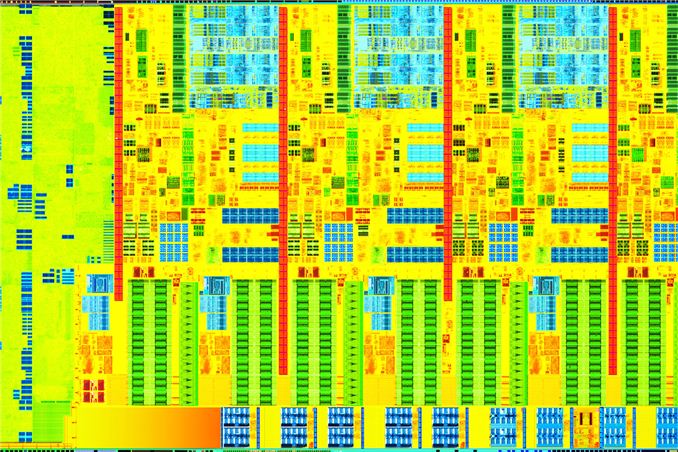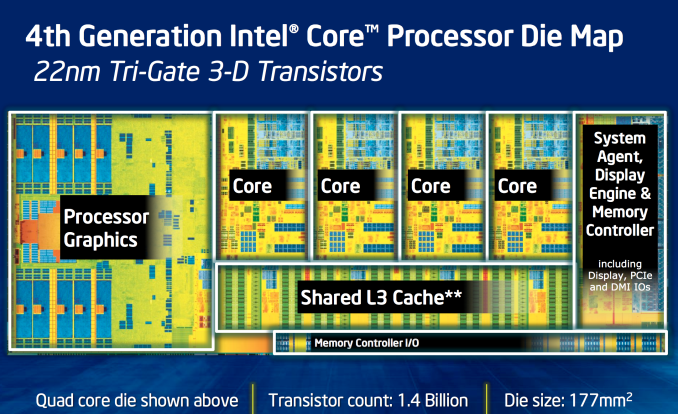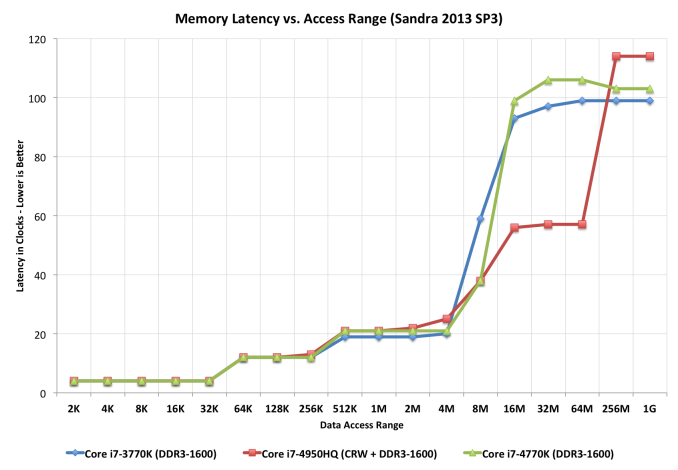The Haswell Review: Intel Core i7-4770K & i5-4670K Tested
by Anand Lal Shimpi on June 1, 2013 10:00 AM EST
This is a very volatile time for Intel. In an ARM-less vacuum, Intel’s Haswell architecture would likely be the most amazing thing to happen to the tech industry in years. In mobile Haswell is slated to bring about the single largest improvement in battery life in Intel history. In graphics, Haswell completely redefines the expectations for processor graphics. There are even some versions that come with an on-package 128MB L4 cache. And on the desktop, Haswell is the epitome of polish and evolution of the Core microprocessor architecture. Everything is better, faster and more efficient.
There’s very little to complain about with Haswell. Sure, the days of insane overclocks without touching voltage knobs are long gone. With any mobile-first, power optimized architecture, any excess frequency at default voltages is viewed as wasted power. So Haswell won’t overclock any better than Ivy Bridge, at least without exotic cooling.
You could also complain that, for a tock, the CPU performance gains aren’t large enough. Intel promised 5 - 15% gains over Ivy Bridge at the same frequencies, and most of my tests agree with that. It’s still forward progress, without substantial increases in power consumption, but it’s not revolutionary. We compare the rest of the industry to Intel’s excellent single threaded performance and generally come away disappointed. The downside to being on the top is that virtually all improvements appear incremental.
The fact of the matter is that the most exciting implementations of Haswell exist outside of the desktop parts. Big gains in battery life, power consumption and even a broadening of the types of form factors the Core family of processors will fit into all apply elsewhere. Over the coming weeks and months we’ll be seeing lots of that, but today, at least in this article, the focus is on the desktop.
Haswell CPU Architecture Recap
Haswell is Intel’s second 22nm microprocessor architecture, a tock in Intel’s nomenclature. I went through a deep dive on Haswell’s Architecture late last year after IDF, but I’ll offer a brief summary here.
At the front end of the pipeline, Haswell improved branch prediction. It’s the execution engine where Intel spent most of its time however. Intel significantly increased the sizes of buffers and datastructures within the CPU core. The out-of-order window grew, to feed an even more parallel set of execution resources.
Intel added two new execution ports (8 vs 6), a first since the introduction of the Core microarchitecture back in 2006.
On the ISA side, Intel added support for AVX2, which includes an FMA operation that considerably increases FP throughput of the machine. With a doubling of peak FP throughput, Intel doubled L1 cache bandwidth to feed the beast. Intel also added support for transactional memory instructions (TSX) on some Haswell SKUs.
The L3 cache is now back on its own power/frequency plane, although most of the time it seems to run in lockstep with the CPU cores. There appears to be a 2 - 3 cycle access penalty as a result of decoupling the L3 cache.


















210 Comments
View All Comments
jmcb - Saturday, June 1, 2013 - link
I currently have an E8400 so the Haswell would be amazing....but I will go for amazing and value._zenith - Saturday, June 1, 2013 - link
"Even on the dekstop" - desktop. Just spelling gripe.I notice the gains over Nehalem are pretty much the same that you can *easily* get (just increase VCore and BCLK) out of overclocking Nehalem. So now they're neck and neck if you don't overclock the Haswell part. Maybe my system will be good for another year now! (i7-920 @ 4.0).
Da W - Saturday, June 1, 2013 - link
YeehaaaNow i can buy my Trinity + Radeon rig for the price of a haswell only rig. I know it will play every videogame made for xbox or PS4 for the next 7-8 years and make a perfect HTPC!
ChefJeff789 - Saturday, June 1, 2013 - link
I've been sitting on a first-gen Core i7 and this is still a little dissapointing. It is significantly quicker than mine, but I'm not sure that the upgrade is quite worth it for me yet as everything I use runs reasonably well. I am interested in the new socket type, though. I wonder if upgrading the motherboard with a decent Haswell would benefit me later on with a Skylake. It's hard to say; I haven't seen any firm specs on the socket-type for the Skylake chips.jwcalla - Saturday, June 1, 2013 - link
At this point I think there are more interesting places to put your tech dollars. A high-DPI display or triple monitors if you're into gaming, more SSDs if you need the space, a NAS or a nice tablet, etc. I'm in your camp with an i7-870 and nothing I do pushes it enough to test my patience.kyuu - Saturday, June 1, 2013 - link
Agreed -- unless you're loaded, there are far more interesting ways to spend your money in the PC arena than on the overhyped and underwhelming Haswell SKUs. Unless you're still stuck on Phenom II or Core2Duo.bji - Sunday, June 2, 2013 - link
Hey - I'm still "stuck" on a Phenom II (in my desktop; laptop is 15 inch rMBP with Ivy Bridge) and it's not that bad. It's significantly slower than the Bridges in single threaded apps but even so it's fast enough that I never notice, much like jwcalla never notices with his i7-870. And the Phenom II x6 has 6 real cores that do decently well in heavily multithreaded apps, really extensive compiles being the only thing that I ever do that would benefit at all from extra speed. 6 real cores holding their own reasonably well there. Even if an Ivy Bridge were 50% faster per core on the compiles (and it probably is), the x6 has 50% more cores so it kind of evens out ...rabbatabba - Sunday, June 2, 2013 - link
Anyone know if x264 is properly optimized for AVX2? Naiively, one might expect a 2x speedup for SIMD integer dominated code over the AVX1-only 2700k provided that the rest of the system is able to shuffle around data.http://com3.tv/wp-content/uploads/2012/09/Haswell-...
I am very curious as to the real-world performance gains of integer (and floating-point FMA) SIMD code in Haswell compared to previous generations.
Klimax - Sunday, June 2, 2013 - link
It has support for AVX2. Not sure in how many places, but over months there was stream of AVX2 code paths.plopingo - Sunday, June 2, 2013 - link
No need for me to upgrade with my I7 960@4.2ghzmaybe next time :D